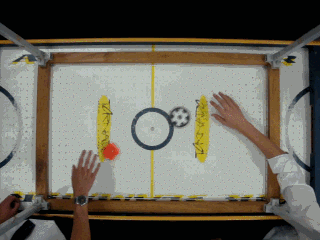Many of these ideas have been introduced in Stage 1 through one-dimensional situations. The focus here should be on two-dimensional situations.
Momentum is a property of moving objects and is defined as the product of the mass and the velocity of the object. It is conserved in an isolated system and may be transferred from one object to other objects when a force acts over a time interval.
Kinetic energy is a property of moving objects, and is given by the formula 
Newton’s Second Law of Motion can be expressed as two formulae,  and
and  , where
, where  is the momentum of the object.
is the momentum of the object.
- Derive
 by substituting the defining formula for acceleration
by substituting the defining formula for acceleration  into Newton’s Second Law of Motion,
into Newton’s Second Law of Motion,  for particles of fixed mass. (The net force, F and hence the acceleration, a are assumed to be constant. Otherwise, average or instantaneous quantities apply.)
for particles of fixed mass. (The net force, F and hence the acceleration, a are assumed to be constant. Otherwise, average or instantaneous quantities apply.) - Draw vector diagrams in which the initial momentum is subtracted from the final momentum, giving the change in momentum,
 .
. - Solve problems (in both one dimension and two dimensions) using the formulae
 ,
,  and
and  .
.
Newton’s Third Law of Motion in conjunction with the Second Law expressed in terms of momentum, implies that the total momentum of a system of two interacting particles, subject only to the force of each one on the other, is conserved.
- Derive a formula expressing the conservation of momentum for two interacting particles by substituting
 and
and  into Newton’s Third Law.
into Newton’s Third Law. - Use the law of the conservation of momentum to solve problems in one and two dimensions.
- Analyse multi-image representations to solve conservation of momentum problems, using only situations in which the mass of one object is an integral multiple of the mass of the other object(s). The scale of the representations and the flash rate can be ignored.
The conservation of momentum can be used to explain the propulsion of spacecraft, ion thrusters, and solar sails.
- Use the conservation of momentum to describe and explain the change in momentum and acceleration of spacecraft due to the emission of gas particles or ionised particles.
- Use the conservation of momentum to describe and explain how the reflection of particles of light (photons) can be used to accelerate a solar sail.
- Use vector diagrams to compare the acceleration of a spacecraft, using a solar sail where photons are reflected with the acceleration of a spacecraft, using a solar sail where photons are absorbed.
The Incredible Sounds of the Falcon Heavy Launch
Dartbox (Construct capx)

